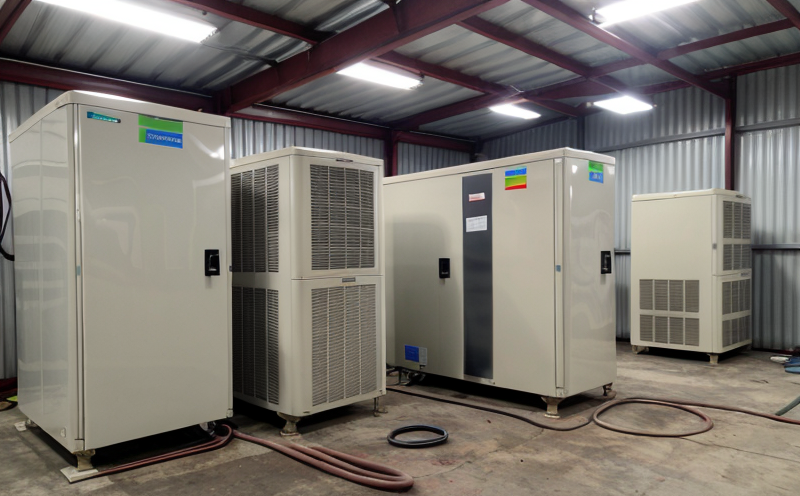EN 14624-1 Refrigerant Tightness Verification
The EN 14624 series of standards provides a comprehensive framework for ensuring the safe and reliable operation of HVAC (Heating, Ventilation, and Air Conditioning) equipment. Specifically, EN 14624-1 Refrigerant Tightness Verification focuses on assessing the integrity of refrigerants in various HVAC systems to ensure they do not leak, which is critical for both safety and environmental compliance.
The process involves a series of tests designed to verify that the system maintains its pressure within acceptable limits over time. This ensures that the equipment operates efficiently and safely, preventing potential hazards such as frost build-up or the release of harmful refrigerants into the atmosphere. The test is essential for HVAC systems using refrigerants like R-410A, R-32, and others.
The testing procedure outlined in EN 14624-1 involves several key steps:
- Preparation of the System: The system is first prepared by ensuring that all connections are secure. Any refrigerant present in the system should be evacuated to a level acceptable for testing.
- Injection of Test Gas: A test gas, typically nitrogen (N₂), is introduced into the system at specific pressure levels as per the standard's requirements.
- Pressure Holding Period: The system remains under pressure during this period to allow any leaks to develop or become apparent. This step can last from 24 to 72 hours depending on the complexity of the system and the type of refrigerant used.
- Detection and Analysis: Leaks are detected using appropriate instruments, such as electronic leak detectors or vacuum gauges, which monitor any pressure drop indicative of a leak. Once identified, leaks should be repaired before re-testing to ensure compliance.
- Re-Verification: After repairs, the system is re-tested to confirm that all defects have been corrected and the integrity of the system has been restored.
The results are documented in a detailed report that includes all relevant data from the testing process. This ensures that equipment operators can maintain compliance with local regulations while also contributing positively towards environmental sustainability by reducing refrigerant emissions.
Compliance to this standard is crucial for HVAC professionals, especially those involved in quality management and R&D, as it guarantees that the systems they work on are reliable and safe for use. This test ensures not only operational efficiency but also helps maintain a clean environment by preventing unwanted emissions of harmful substances into the atmosphere.
Why Choose This Test
The EN 14624-1 Refrigerant Tightness Verification test is an essential component of ensuring HVAC equipment operates safely and efficiently. By choosing this test, organizations can achieve several key benefits:
- Enhanced Safety: Ensures that refrigerants do not escape into the environment, which could pose risks to both personnel and the ecosystem.
- Regulatory Compliance: Adherence to international standards like EN 14624 helps meet legal requirements set by governments worldwide.
- Economic Benefits: By preventing leaks early on, organizations save money on unnecessary replacements and repairs. Additionally, this test can help extend the lifespan of HVAC systems.
- Environmental Responsibility: Preventing refrigerant leaks reduces greenhouse gas emissions, contributing positively to global efforts against climate change.
In summary, selecting EN 14624-1 Refrigerant Tightness Verification as part of your quality assurance process ensures that all aspects related to the integrity of HVAC systems are meticulously checked and maintained at optimal levels. This commitment translates into safer working environments, cost savings, adherence to regulations, and reduced environmental impact.
International Acceptance and Recognition
The EN 14624 series has gained widespread acceptance across Europe and beyond. This standard is recognized by numerous countries, including those in the European Union (EU), as well as regions like North America and Asia-Pacific.
- European Union: All EU member states require compliance with EN 14624-1 for HVAC equipment used within their territories. The standard is part of the harmonization process aimed at creating a single market for products in Europe, ensuring that manufacturers adhere to consistent quality and safety standards.
- North America: Although not mandatory, many large corporations and industry associations recommend compliance with EN 14624-1 for HVAC equipment installed in North American facilities. This is due to the growing trend towards adopting international best practices across borders.
- Asia-Pacific: Some countries within this region have started to incorporate elements of EN 14624 into their national standards, reflecting a global shift towards more stringent environmental and safety regulations.
The consistent application of these tests not only enhances the reputation of manufacturers but also fosters trust among consumers who rely on reliable HVAC systems for comfort and health. By choosing this test, organizations signal to stakeholders that they are committed to maintaining high standards in their operations.
Environmental and Sustainability Contributions
The importance of preventing refrigerant leaks cannot be overstated. Refrigerants, especially those used in HVAC systems like R-410A and R-32, are potent greenhouse gases that can significantly contribute to global warming if released into the atmosphere. By adhering to EN 14624-1, organizations play a crucial role in mitigating this risk.
- Reduction of Greenhouse Gas Emissions: Leakage detection and repair practices as outlined by EN 14624 help minimize the amount of refrigerant that escapes into the atmosphere. This contributes to lowering overall greenhouse gas emissions, supporting global efforts to combat climate change.
- Sustainable Resource Management: Ensuring proper containment of refrigerants promotes efficient use of natural resources and reduces waste associated with discarded equipment containing unneeded or harmful substances.
- Enhanced Efficiency: Tightness verification helps maintain the efficiency of HVAC systems, leading to lower energy consumption and reduced carbon footprints. This contributes directly to sustainability goals by optimizing resource utilization within buildings.
In conclusion, embracing EN 14624-1 Refrigerant Tightness Verification not only upholds safety standards but also aligns with broader environmental objectives. It demonstrates a commitment to responsible stewardship of resources and safeguarding our planet for future generations.





